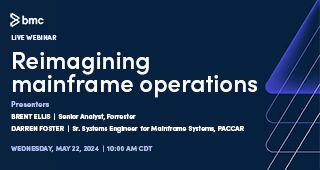The word is out! BMC AMI Ops Monitoring delivers a significant financial return. How significant? According to the recently released and commissioned The Total Economic Impact™ of BMC AMI Ops Monitoring study conducted by Forrester Consulting on behalf of BMC, a 130 percent return on investment (ROI), a net present value (NPV) of $2.94 million, and a benefits present value (PV) of $5.19 million over three years. These positive results are driven by halving unplanned mainframe outages, achieving significant cost savings from retiring outdated legacy systems, and reallocating full-time employees to more critical tasks to enhance overall productivity.
BMC AMI Ops Monitoring yielded these results with an integrated solution that automates actions and centralizes control across mainframe environments by monitoring operating systems, databases, networks, middleware, and storage; optimizing performance; and minimizing downtime risks. Additionally, the solution’s advanced automation and observability features enable organizations to proactively manage their mainframes, detecting and resolving issues before they impact operations. This comprehensive approach improves operational efficiency and supports strategic business growth by ensuring high system availability and performance.
130 percent ROI—A closer look
Let’s dive into insights gathered by Forrester Consulting through interviews with professionals who have hands-on experience with the solution. The results were aggregated and combined to form a single composite organization. Weaving together their experiences and analyzing the ROI, Forrester analysts crafted a compelling narrative.
The study found that, in addition to reduced MSU usage and improved visibility, the composite company representing the research achieved a 50 percent reduction in unplanned outage downtime, resulting in a $1.4 million retained profit over three years.
“We’ve cut downtime in half with BMC AMI Ops Monitoring. Monitoring all in one place has really given us that ability in a way that we didn’t have before.”
—VP of operations, financial services
$4M+ in legacy solution cost savings
Also, by consolidating and automating monitoring, the composite company reduced retired legacy solutions costs by 80 percent and achieved a three-year total savings of $4,050,000.
“BMC has allowed us to reduce the number of licenses and the number of the functionality that we need from our legacy solution. We will potentially eliminate it entirely, which will generate even more savings going forward.”
—VP of operations, financial services
$607k savings by reallocating full-time monitoring employees
As the composite company shows, organizations face the challenge of reducing costs while monitoring numerous environments and navigating a shortage of mainframe talent―all while handling increasingly active and unpredictable workloads.
“Prior to [BMC] AMI Ops, with the legacy system, we had multiple people monitoring usage for multiple platforms. BMC allowed me to reallocate probably three full-time employees from monitoring into other departments and to other areas of the firm. We were able to repurpose them.”
—VP of operations, financial services
Nine-to-five isn’t a thing anymore; every hour is a business hour. Across demographic groups, customers are using the web and online applications to conduct banking transactions, make changes to their insurance, keep track of medical records, or even buy groceries—and they expect instant response times from 24×7 service availability. Minimizing downtime, whether planned or unplanned, can mean the difference between delighting customers and losing them to competitors.
Proactive root-cause analysis to address performance issues before they occur
Whether in mainframe operations or everyday life, an informed, proactive approach is preferable to reactive “firefighting.” Waiting for issues to develop, seeking out their root causes, and then working to resolve them costs the business precious time and leaves you vulnerable to even more significant delays if further problems develop.
“BMC saves me time performing day-to-day tasks by proactively driving to root-cause analysis. The automation and intelligence that the product is giving us helps us make decisions in a timely manner.”
—Technical support manager, insurance
Knowing what caused previous issues, looking for warning signs, and working to prevent those issues gives you a clear advantage. Operations teams that use manual processes and rely on several monitoring solutions can easily miss not only warning signs but also active issues, leading to costly outages and extended resolution times. And it’s nearly impossible for operators, regardless of their experience, to keep track of past issues and their causes while simultaneously monitoring and analyzing multiple environments for similar trends.
BMC AMI Ops Monitoring helps avoid these situations by analyzing both historical and real-time data, all in a single view. Armed with the knowledge of conditions that have led to issues in the past, as well as the ability to monitor for the recurrence of these conditions, it informs operations teams that trouble is brewing, allowing them to reallocate resources and work to fix problems before they even happen. Combined with a real-time view of critical resources and usage metrics across multiple mainframe environments, this gives teams unprecedented visibility into system health.
No amount of monitoring will prevent every issue, though. When problems do arise, BMC AMI Ops Monitoring doesn’t leave teams guessing. Providing guided navigation to the source of the issues helps teams identify problem components and processes and reduce mean time to resolution (MTTR).
Ensuring high performance
Even when things work normally, mainframe operations teams are busy maximizing resource usage efficiency while keeping costs low and maintaining maximum availability. They can’t rely on traditional slow periods, such as overnight hours or weekends, to conduct maintenance or fine-tune their systems. As transaction and data volume increase and become more unpredictable, they must adjust their practices to ensure maximum uptime and customer satisfaction.
“With BMC AMI Ops Monitoring, it’s a one-stop-shop, comprehensive solution. We can use this on one console rather than using a combination of [point solution], some in-house functionality, and other systems. It’s allowed us to streamline our staff and put certain people in charge of certain functionality in a way that we were unable to before. It’s improved efficiency a great deal.”
—VP of operations, financial services
By offering real-time monitoring and a single point of control for multiple systems, BMC AMI Ops Monitoring empowers operations teams to reallocate resources, adjust parameters, and make system changes without costly downtime. This standardized, single-view system also helps onboard new team members faster and empowers less-experienced operators, improving workforce efficiency and simplifying monitoring to deliver additional cost savings.
A positive impact
As shown in the study, the enhanced visibility, actionable insights, and increased efficiency offered by BMC AMI Ops Monitoring not only lead to improved system availability but also help streamline operations and reduce costs, positively impacting your organization’s bottom line and your customers’ satisfaction.
To learn more about the quantified and unquantified benefits of adoption and see more of the findings, read The Total Economic Impact™ of BMC AMI Ops Monitoring.







